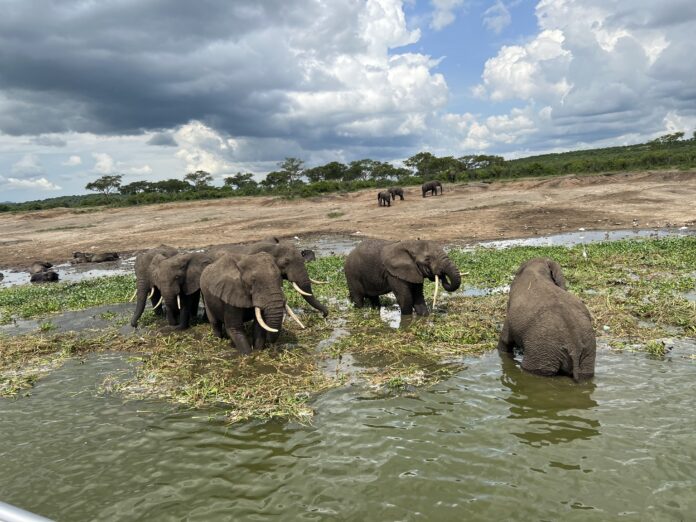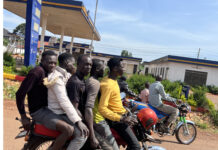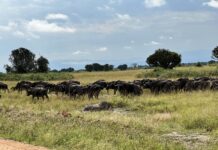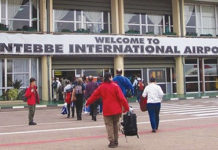Where is Uganda Located?
Uganda is a landlocked country located in East Africa. It is bordered by South Sudan to the north, Kenya to the east, Tanzania to the south, Rwanda to the southwest, and the Democratic Republic of the Congo to the west. Its geographic coordinates are approximately between latitude 1°N and 4°S, and longitude 29°E and 35°E. Below we bring you a complete Uganda Travel Guide to consider for anyone planning a trip to Uganda.
What is Uganda best known for?
Wildlife and National Parks: Uganda is renowned for its diverse wildlife and national parks. The country is home to several iconic species, including mountain gorillas, chimpanzees, elephants, lions, and giraffes. Bwindi Impenetrable National Park and Mgahinga Gorilla National Park are particularly famous for gorilla trekking.
Source of the Nile: The River Nile, the longest river in Africa, has its source in Uganda. Jinja, a town located on the shores of Lake Victoria, is known as the “Source of the Nile” and is a popular destination for tourists.
Gorilla Trekking: Uganda is one of the few countries where you can go gorilla trekking and have an up-close encounter with these incredible creatures. The Bwindi Impenetrable National Park and Mgahinga Gorilla National Park offer opportunities for gorilla trekking experiences.
Idi Amin’s Regime: Uganda gained international attention during the brutal regime of President Idi Amin, who ruled the country from 1971 to 1979. His dictatorship was marked by human rights abuses and political instability, making him one of the most infamous leaders in African history.
Cultural Diversity: Uganda is home to over 50 different ethnic groups, each with its own distinct culture, traditions, and languages. The country’s cultural diversity is often celebrated through music, dance, arts and crafts, and various cultural festivals.
Mount Rwenzori: Located on the border between Uganda and the Democratic Republic of the Congo, Mount Rwenzori is the third highest peak in Africa. Known as the “Mountains of the Moon,” it offers challenging mountaineering and trekking experiences for adventure enthusiasts.
Coffee Production: Uganda is one of the largest coffee producers in Africa. The country’s favorable climate and fertile soil contribute to the cultivation of high-quality Arabica and Robusta coffee beans, making coffee an important agricultural export.
How to get to Uganda
By Air: Entebbe International Airport, located near the capital city of Kampala, is the main international gateway to Uganda. Many major airlines offer flights to Entebbe from various cities around the world. You can check with airlines or travel websites to find the most convenient flights from your location.
Connecting Flights: If there are no direct flights to Entebbe from your location, you may need to take a connecting flight. Common transit hubs for flights to Uganda include major African cities such as Nairobi (Kenya), Addis Ababa (Ethiopia), Kigali (Rwanda), and Johannesburg (South Africa). From these hubs, you can find connecting flights to Entebbe.
Overland Travel: If you are in a neighboring country, you can choose to travel to Uganda by land. Uganda shares borders with several countries, including Kenya, Tanzania, Rwanda, South Sudan, and the Democratic Republic of the Congo. You can use public buses, taxis, or private vehicles where you can hire a car with a driver to cross the border and reach Uganda.
Visa Requirements: Before traveling to Uganda, make sure to check the visa requirements for your nationality. Some countries may require a visa in advance, while others may be eligible for visa-on-arrival or e-visa options. It is recommended to check with the Ugandan embassy or consulate in your country for the most up-to-date visa information.
Travel Advisories: Before your trip, it is important to stay informed about travel advisories and any specific entry requirements or restrictions due to current events or health concerns. Check the official government websites of your home country and Uganda, as well as international travel advisories, for the latest updates.
The most important places to visit in Uganda
Bwindi Impenetrable National Park: Known for its population of endangered mountain gorillas, Bwindi Impenetrable National Park is a top attraction in Uganda. Gorilla trekking is the main activity, allowing visitors to observe these majestic creatures up close in their natural habitat.
Queen Elizabeth National Park: This diverse national park is home to a variety of wildlife, including elephants, lions, leopards, hippos, and a large number of bird species. Visitors can enjoy game drives, boat safaris on the Kazinga Channel, and chimpanzee tracking in the Kyambura Gorge.
Murchison Falls National Park: Situated along the Nile River, Murchison Falls National Park offers stunning scenery and abundant wildlife. The park is famous for its waterfall, where the Nile squeezes through a narrow gorge, creating a powerful and breathtaking cascade. Game drives, boat cruises, and hiking to the top of the falls are popular activities.
Kibale National Park: Known as the primate capital of East Africa, Kibale National Park is renowned for its chimpanzee population. Visitors can take part in chimpanzee tracking and trekking, as well as encounter other primates such as red colobus monkeys and black-and-white colobus monkeys.
Lake Mburo National Park: This compact park is characterized by its scenic landscapes and abundant wildlife. Visitors can enjoy game drives, boat safaris, horseback riding, and guided nature walks. Lake Mburo National Park is known for its zebra population and offers a chance to see various antelope species.
Jinja: Located on the shores of Lake Victoria, Jinja is a popular destination for adventure seekers. It is known as the adventure capital of East Africa, offering activities like white-water rafting, kayaking, bungee jumping, and quad biking. Jinja is also the gateway to the Source of the Nile.
Rwenzori Mountains National Park: This park is home to the snow-capped Rwenzori Mountains, also known as the “Mountains of the Moon.” It offers a challenging yet rewarding trekking experience for mountaineers and nature enthusiasts. The park is known for its unique flora and fauna.
Sipi Falls: Located in the eastern part of Uganda, Sipi Falls is a picturesque series of three waterfalls nestled in the Mount Elgon region. Visitors can hike to the falls, explore the beautiful surroundings, and enjoy stunning views of the countryside.
When is the best time to visit Uganda?
The best time to visit Uganda largely depends on your preferences and the activities you plan to engage in during your trip. However, there are a few general recommendations:
Dry Season (December to February and June to September):
During the dry season, Uganda experiences less rainfall, making it a popular time for tourism. The weather is generally sunny and pleasant, and it’s an ideal time for wildlife viewing, gorilla trekking, and other outdoor activities. However, it is worth noting that due to the popularity of this season, parks and accommodations can be more crowded, and gorilla permits may be in high demand, so it is advisable to book in advance.
Wet Season (March to May and October to November):
The wet season in Uganda is characterized by more rainfall. While it might be less crowded during this time, some roads and trails may become muddy and impassable, and wildlife can be more challenging to spot due to the denser vegetation. However, the landscapes are lush and green, and the birdlife is abundant. It can also be a good time for discounted rates on accommodations and permits.
It’s important to note that Uganda’s climate varies across different regions and altitudes, so the weather conditions can differ. It’s a good idea to check specific regional weather patterns when planning your visit.
What should I pack when traveling to Uganda?
When traveling to Uganda, it’s important to pack appropriately to ensure a comfortable and enjoyable trip. Here are some essential items to consider:
Clothing:
Lightweight and breathable clothing: Uganda’s climate is generally warm, so pack lightweight and breathable clothing such as t-shirts, shorts, and lightweight pants.
Long-sleeved shirts and pants: These can provide protection against mosquitoes, especially in the evenings.
Rain gear: Uganda experiences rainfall throughout the year, so pack a waterproof jacket or poncho and quick-drying pants.
Comfortable walking shoes: Pack sturdy and comfortable shoes for outdoor activities and hikes.
Swimwear: If you plan to visit lakes or swimming pools, bring swimwear.
Insect Repellent:
Mosquitoes can be present in Uganda, particularly in certain regions. Pack insect repellent containing DEET or other effective ingredients to protect yourself from mosquito bites.
Travel Documents and Money:
Passport: Ensure your passport is valid for at least six months beyond your intended stay and has necessary entry visas.
Visa: Check the visa requirements for your nationality and obtain the appropriate visa before traveling or upon arrival.
Travel insurance: It’s recommended to have travel insurance that covers medical emergencies and trip cancellation.
Cash and cards: Carry a mix of cash (in local currency, Ugandan Shillings) and international credit/debit cards. ATMs are available in major towns and cities.
Health and Hygiene:
Prescription medications: If you take any prescription medications, bring an adequate supply for your trip.
Personal toiletries: Pack essentials like toiletries, sunscreen, hand sanitizer, and any other personal care items you may need.
First aid kit: Include basic items like adhesive bandages, antiseptic cream, pain relievers, and any specific medications or supplies you may require.
Electronics and Miscellaneous:
Adapter plugs: Uganda uses Type G power outlets, so bring an appropriate adapter if needed.
Electronics: Pack your camera, charger, power banks, and any other electronics you may need.
Binoculars: Useful for wildlife viewing and birdwatching.
Travel guidebook and maps: Consider bringing a guidebook or map to help navigate and learn more about Uganda.
What are the best Uganda guidebooks?
“Lonely Planet Uganda” – Lonely Planet is known for its comprehensive and detailed travel guides, and “Lonely Planet Uganda” is a popular choice. It offers practical information, maps, cultural insights, and recommendations for various destinations and activities in Uganda.
“Bradt Travel Guide Uganda” – The Bradt travel guide series is well-regarded for its in-depth coverage of destinations. “Bradt Travel Guide Uganda” provides extensive information on Uganda’s national parks, wildlife, culture, and practical travel advice.
“Uganda – Culture Smart: The Essential Guide to Customs & Culture” – This guidebook, part of the “Culture Smart!” series, focuses on understanding the cultural nuances, customs, and etiquette of Uganda. It provides insights into the local culture, traditions, and practical tips for interacting with locals.
What Languages are spoken in Uganda?
Uganda is a linguistically diverse country with over 40 different languages spoken throughout its regions. However, the official language of Uganda is English. English serves as the medium of instruction in schools, is widely used in government institutions, and is the language of business and commerce. Swahili, which is widely spoken in East Africa is mostly used by the business people and the armed security people.
In addition to English, there are several indigenous languages spoken in Uganda. Some of the major local languages include:
Luganda: This is the most widely spoken language in Uganda and is predominantly spoken by the Baganda people in the central region, including Kampala, the capital city.
Runyankole-Rukiga: Spoken by the Banyankole and Bakiga people in the southwestern part of Uganda, this language is divided into two dialects, Runyankole and Rukiga.
Acholi: Spoken by the Acholi people in the northern region of Uganda, primarily in districts like Gulu, Apac, Lira, and Kitgum.
Lusoga: This language is spoken by the Basoga people in the eastern region, including Jinja Kamuli, Mayuge, Bugiri, and Iganga.
Ateso: Spoken by the Iteso people in the eastern part of the country, particularly in Soroti, Ngora, Mbale, and Kumi.
These are just a few examples of the local languages spoken in Uganda. The linguistic diversity reflects the country’s rich cultural heritage and is an integral part of its identity.
What Currencies are accepted in Uganda?
The official currency of Uganda is the Ugandan Shilling (UGX). When traveling to Uganda, it is best to carry Ugandan Shillings for day-to-day transactions, as it is the widely accepted currency throughout the country.
While Ugandan Shillings are the primary currency, some businesses and establishments, particularly in tourist areas or larger cities, may accept major foreign currencies such as the United States Dollar (USD), Euro (EUR), British Pound (GBP), or Kenyan Shilling (KES) for certain transactions, such as payment for accommodations or high-value purchases.
It is advisable to have some Ugandan Shillings in cash for smaller purchases, transportation, and local markets. Currency exchange services are available at banks, forex bureaus, and some hotels in major towns and cities.
Keep in mind that if you pay in foreign currency, you may receive change in Ugandan Shillings. It’s recommended to carry smaller denominations of foreign currency and check the exchange rates beforehand to ensure fair transactions. Note that dollar notes below $50 notes attract a lower exchange rate value, the same applies to torn notes, as well as notes below series 2013.
Credit and debit cards are accepted at some upscale hotels, restaurants, and larger establishments in major cities. However, it is advisable to carry cash for smaller businesses, rural areas, and when traveling outside urban centers, as card acceptance may be limited.
Always inform your bank and credit card company about your travel plans to Uganda to avoid any issues with using your cards abroad. Additionally, keep in mind that ATM access may be more limited in rural areas, so it’s recommended to withdraw cash in advance if you plan to venture outside major towns and cities.






